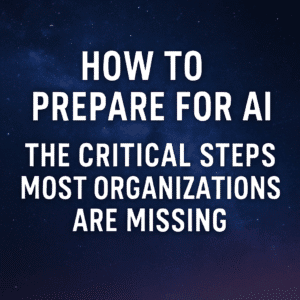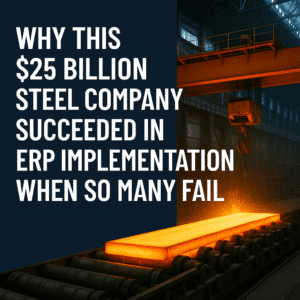When helping organizations with their ERP implementations, many common questions arise. Here, we’ll explore the most frequent inquiries in detail and provide comprehensive insights and answers.
Table of Contents
ToggleWhen Should Requirements Gathering Begin in a Digital Transformation?
A common question is about the timing of requirements gathering. The simple answer is to start as early as possible.
- Early Stage Definition:
- Importance: Starting the requirements gathering process early is crucial. This early stage is where you begin defining high-level business requirements. These initial requirements provide a roadmap for the entire project, ensuring that all stakeholders have a clear understanding of the project’s goals and objectives.
- Scope: Begin with a broad scope to capture the overarching needs of the organization. High-level requirements should include critical business functions, essential features, and key performance indicators that the new ERP system must meet.
- Detailed Requirements:
- Depth: Ideally, all business requirements should be defined, even though this may involve hundreds or thousands of individual requirements. Detailed requirements cover every aspect of the business processes, ensuring that the ERP system will meet all operational needs.
- Avoiding Analysis Paralysis: While it’s important to be thorough, avoid getting bogged down in analysis paralysis. The goal is to have a comprehensive understanding of the requirements without delaying the project. Strike a balance between detail and progress.
- Prioritization:
- Critical Requirements: Once the requirements are gathered, prioritize them based on their importance to the business. Identify which requirements are critical to the core operations and which ones are less urgent.
- Impact on Selection: Prioritizing requirements helps narrow down software options during the evaluation phase. It ensures that the chosen ERP system aligns with the most critical business needs.
- Continuous Refinement:
- Iterative Process: Requirements gathering is not a one-time task. It should be an iterative process where requirements are continuously reviewed and refined as more information becomes available and as the project evolves.
When Should Business Process Improvement Begin?
Should business process improvement occur before, after, or during software implementation? The answer is both.
- Initial Process Definition:
- Macro-Level Planning: Initially, define the future state at a macro level, focusing on levels 1 and 2 of a five-layer process map. Level 1 includes the highest-level processes, while level 2 breaks these down into more detailed subprocesses. This early definition helps create a framework for evaluating software options.
- Guidance for Evaluation: High-level process definitions provide guidance to vendors during software demos. They ensure that the proposed solutions align with the organization’s strategic goals and operational needs.
- Mid-Level Refinement:
- Blueprinting Phase: As the project progresses, refine these processes to levels 3 and 4. Level 3 details specific activities within subprocesses, while level 4 includes detailed steps and decision points. This level of detail is crucial during the blueprinting phase, where specific requirements are mapped to software capabilities.
- Stakeholder Involvement: Engage key stakeholders from various departments to ensure that the refined processes reflect the actual workflows and address any potential issues.
- Detailed Design and Implementation:
- Level 4 and 5 Processes: Finally, during the detailed design and implementation phase, get into levels 4 and 5, which involve detailed workflows and step-by-step transactions. Level 5 includes the most granular details, such as individual tasks and system interactions.
- Vendor Collaboration: Collaborate closely with the software vendor to ensure that the detailed processes are accurately configured and implemented in the ERP system.
- Avoiding Common Pitfalls:
- Vendor Pressure: Avoid the common pitfall of skipping levels 1 through 3 due to vendor pressure. Vendors might suggest going straight to detailed design, but this can lead to misalignment between business needs and software capabilities.
- Foundation for Success: High-level process definitions serve as a foundation for the entire project. They ensure that the ERP implementation is aligned with the organization’s strategic objectives.
When Should Change Management Begin?
Change management should start now, regardless of where the project is in the process.
- Early Initiation:
- Immediate Action: Change management should be initiated as soon as the decision to implement a new ERP system is made. This early start is critical because change management involves preparing the organization for significant changes in processes, technology, and roles.
- Cultural Shift: ERP implementation often requires a cultural shift within the organization. Employees need time to adapt to new ways of working, and early change management efforts help facilitate this transition.
- Organizational Readiness Assessment:
- Assessment Importance: Begin with an organizational readiness assessment to measure the current state of the organization. This assessment identifies areas of strength and potential risks from an organizational and human perspective.
- Customized Change Strategy: Use the results of the readiness assessment to design a customized change strategy. This strategy should address specific challenges and leverage organizational strengths to ensure a smooth transition.
- Comprehensive Change Plan:
- Plan Components: A comprehensive change management plan includes communication strategies, training programs, and stakeholder engagement activities. Effective communication ensures that all employees understand the reasons for the change and their role in the new system.
- Training Programs: Develop training programs tailored to different user groups. Training should cover not only the technical aspects of the new ERP system but also the changes in business processes and workflows.
- Ongoing Support:
- Sustained Efforts: Change management is an ongoing effort that extends beyond the go-live date. Continuous support, feedback mechanisms, and additional training sessions help ensure that employees fully adopt the new system and processes.
- Monitoring and Adjustment: Regularly monitor the progress of change management initiatives and make adjustments as needed. Address any resistance or issues promptly to keep the project on track.
Why Do ERP Implementations Fail?
Understanding why ERP implementations fail is crucial. The two main reasons are unrealistic expectations and misalignment.
- Unrealistic Expectations:
- Setting Realistic Goals: Unrealistic expectations often stem from underestimating the complexity and scope of an ERP implementation. Organizations may set overly ambitious timelines and budgets, leading to rushed decisions and compromised quality.
- Impact on Budget and Time: Unrealistic expectations result in budget overruns and missed deadlines. The project team may be forced to cut corners, skip critical steps, or make poor decisions to meet the unrealistic goals.
- Misalignment:
- Organizational Alignment: Misalignment occurs when the organization is not on the same page about goals, strategies, and priorities. Different departments may have conflicting objectives, leading to confusion and inefficiency.
- Common Direction: To prevent misalignment, spend time upfront clearly defining what the organization aims to achieve with the ERP implementation. Develop a shared vision and strategy that all stakeholders agree upon.
- Mitigation Strategies:
- Clear Communication: Ensure clear and consistent communication throughout the project. Regularly update all stakeholders on progress, changes, and challenges.
- Stakeholder Engagement: Engage stakeholders from all levels of the organization in the planning and implementation process. Their input and buy-in are crucial for project success.
- Realistic Planning:
- Detailed Planning: Develop a detailed project plan that includes realistic timelines, budgets, and resource allocations. Factor in potential risks and contingencies to avoid surprises.
- Vendor Collaboration: Work closely with vendors to understand the capabilities and limitations of the chosen ERP system. Ensure that the system aligns with the organization’s requirements and can be implemented within the planned timeframe.
Can a System Integrator Be a One-Stop Shop for the Entire ERP Implementation?
While a system integrator can theoretically handle the entire ERP implementation, it’s not advisable.
- Specialization and Focus:
- Role of System Integrators: System integrators specialize in technology and are experts in configuring, integrating, and implementing ERP systems. They bring valuable technical expertise to the project.
- Limitations: However, system integrators may not cover other critical aspects like organizational change management, business process improvement, and data migration.
- Client Ownership:
- Project Ownership: The client should own the overall implementation. This ownership ensures that the project aligns with the organization’s strategic goals and business needs.
- Managing Workstreams: The client should manage multiple workstreams, including the system integrator’s technical implementation, change management, process improvement, and data migration.
- Leveraging Expertise:
- Technical Expertise: Leverage the system integrator for their technical expertise in ERP implementation. They should handle the configuration, integration, and testing of the system.
- Other Workstreams: For other critical workstreams, engage experts in change management, business process improvement, and data management. These areas require specialized knowledge and experience.
- Program Management:
- Coordinating Efforts: Effective program management is essential for coordinating the efforts of different workstreams. A strong program management team ensures that all aspects of the project are aligned and working towards the same goals.
- Governance and Oversight: Establish a governance framework to oversee the entire project. This framework should include regular progress reviews, risk assessments, and decision-making processes.
Conclusion
By addressing these common questions, this guide aims to provide a clearer path to a successful ERP implementation. Each stage of the process, from requirements gathering and business process improvement to change management and overall project ownership, plays a crucial role in the success of the implementation. If there are more questions or further assistance is needed, don’t hesitate to seek out additional resources and expert advice to ensure a smooth and effective ERP journey.deliver real value and avoid becoming expensive, unused shelfware.

How Can We Help with your Business Transformation
At Third Stage Consulting, we are passionate about empowering organizations to successfully navigate the complexities of digital transformation. Whether you’re embarking on a new transformation journey or aiming to optimize your current processes, our expert team is committed to providing comprehensive support throughout every phase. From initial strategy development to execution and beyond, we work closely with you to ensure that your transformation goals are met efficiently and effectively.





